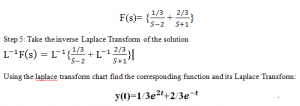6.2 Laplace Transform: Solution of the Initial Value Problems (Inverse Transform)
Laplace transform is used to convert a function in the t domain and transfer it to the s domain. The practical used of this transform is to solve differential equations easier. Having read the definitions and having knowledge on how the Laplace transform works we would proceed with an example in how to apply it to a differential equation with initial values.
1.Solve using Laplace Transform
y”-y’-2y=0 with the condition y(0)=1 y’=0
Step 1: Step 1 is it a differential equation? Yes, because its homogeneous and linear
Step 2: Take the Laplace from both sides L{ y”-y’-2y=0}
Step 3:Solve it algebraically
using the laplace transform chart we know f”(t)= L{f(t)-sf(0)-f'(0)
f'(t)=sL{f(t)-f(0)
Take the Laplace of the diff equation applied the initial value given :
Y(s)-s(1)-0-{sY(s)-1}-2Y(s)
Factor Y(s): Y(s)(-s-2)-s+1=0
Isolate the Y(s) : Y(s)=
therefore take -s+1 to the other side and divide from the quadric equation
Step 4: Simplify the solution by applying partial fraction
= +
= (s-2)(s+1)=A(s+1) = (s-2)(s+1)=B(s-2)
s-1= A(s+1)+B(s-2)
“”= As+A+Bs-2B
“”= As+Bs+A-2B
Combine all the letter that have s with s, and number with the terms that don’t have s on it.
A+B=1 since (1) is in front of the s we use 1 -1=A-2B
Solve the linear equations : we would solve this by using elimination method:
A-2B= -1
2A+2B=2
3A=1 therefore, A=1/3 then by substituting A into the A+B=1– (1/3)+B=1
we obtain B=2/3 and A=1/3
Finally your function is in s domain:
Reminder outline to solving differential equation using Laplace transform:
1. Start with a differential equation
- Take the Laplace Transform from both side of the equation
- Then you would have to simplify the algebraic solution.
- This would require a method like partial fraction
4.Take the inverse Laplace transform of the solution, this would be your solution for the differential equation, at this point you should be in the t domain with a simplify equation
Important Notation:
L{f(t)}: The “L” is used to note that the function {f(t)} laplace transform is being applied.
F(s) : When working with Laplace Transform anything noted with a capital means you are working in s domain. Therefore, F(s) means the function f(t) is already transfer in the s domain.
{F(S)}: is used when working on the inverse laplace transform therefore going back to your function in the t domain.





Pingback: best antique clock dials
Pingback: metal clock dials